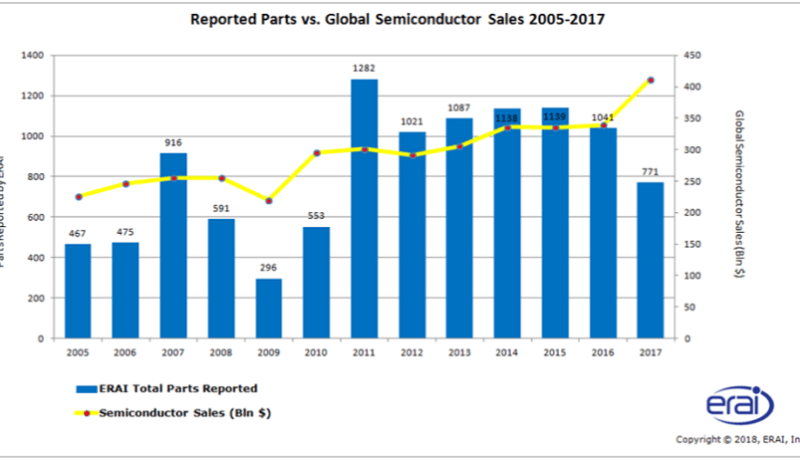Counterfeiting parts waning? Xilinx remains most popular target
June 18, 2018
on
on

ERAI is an organisation that monitors, investigates, and reports issues affecting the global electronics supply chain. Since 2001 one of its ongoing tasks is keeping track of counterfeit electronic components. Whenever you encounter a fake or nonconforming part you can report it to ERAI, or when you have doubts about a part you can ask them for advice.
The current counterfeited-parts situation, up to December 2017 as observed by the organisation, is published in their latest newsletter. It shows that in the previous year clearly fewer counterfeited parts were reported than in earlier years: 771 in 2017 versus 1041 in 2016 or 1139 in 2015 (these figures concern both fake parts and nonconforming parts).
Several reasons can be given for this decline, but it is hard to tell which is the real one. Have fewer parts been copied or have they become more difficult to detect? Or, on the other hand, have electronic component buyers become better at avoiding them?
Whatever the reason may be, the targets of counterfeiters have not changed. As it is more lucrative to invest money in copying expensive parts, it's no surprise that programmable logic (FPGAs) remains the most popular choice whereas microprocessors come second.
Xilinx appears to be the most copied brand, like it was in 2016, with more than twice the number of fakes as compared to its competitors. Again, possibkly Xilinx is better at detecting counterfeits, or maybe their ICs are easier to reverse engineer.
Surprisingly, suppliers of counterfeited parts seem to be mainly located in the USA. Once more, this is a statistic based on reports from volunteers, so the reality may be different.
Fun fact: ERAI is based in counterfeit Naples, Florida, i.e. not in Italy.
Graph: EIRA Blog
The current counterfeited-parts situation, up to December 2017 as observed by the organisation, is published in their latest newsletter. It shows that in the previous year clearly fewer counterfeited parts were reported than in earlier years: 771 in 2017 versus 1041 in 2016 or 1139 in 2015 (these figures concern both fake parts and nonconforming parts).
Several reasons can be given for this decline, but it is hard to tell which is the real one. Have fewer parts been copied or have they become more difficult to detect? Or, on the other hand, have electronic component buyers become better at avoiding them?
Whatever the reason may be, the targets of counterfeiters have not changed. As it is more lucrative to invest money in copying expensive parts, it's no surprise that programmable logic (FPGAs) remains the most popular choice whereas microprocessors come second.
Xilinx appears to be the most copied brand, like it was in 2016, with more than twice the number of fakes as compared to its competitors. Again, possibkly Xilinx is better at detecting counterfeits, or maybe their ICs are easier to reverse engineer.
Surprisingly, suppliers of counterfeited parts seem to be mainly located in the USA. Once more, this is a statistic based on reports from volunteers, so the reality may be different.
Fun fact: ERAI is based in counterfeit Naples, Florida, i.e. not in Italy.
Graph: EIRA Blog
Read full article
Hide full article


Discussion (0 comments)